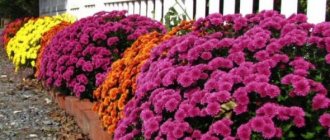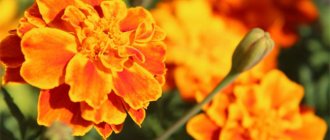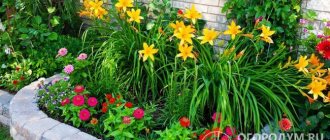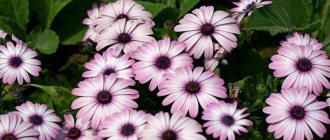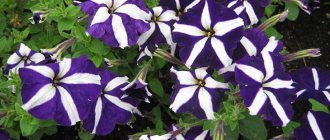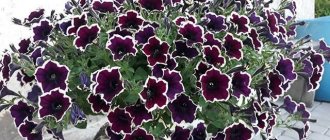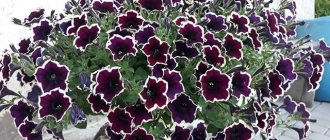In order for the flower bed in the garden to please the eye all summer, you can use both annual and perennial flowers of different colors, shapes and sizes. It is important that the flowering period of the plants be long or strictly seasonal - in the second case, you will have to think about planting in such a way that the flowers bloom, replacing each other.
Let's find out which outdoor flowers are best to plant so that the flower bed remains beautiful and bright throughout the summer.
Annuals
Many gardeners prefer to plant annual flowers - because in this case, the look of the plot will be different every year, you will never get tired of it. Photos of the most popular annuals are below.
These plants allow you to create a beautiful blooming garden immediately in the year of planting, while many perennials bloom only the next year. There are so many species and varieties of annual plants that it will not be difficult to choose suitable options for any area: sunny, shaded, waterlogged, arid, infertile, any other.
In addition, annuals are easy to grow - they are unpretentious and easy to care for. Let's consider the plants most suitable for continuous flowering.
Marigold
This is one of the most common options for decorating flower beds in our country. Marigolds are uniquely unpretentious, and even a child can grow them. Flowering begins early and lasts a long time. You can purchase plants with different petal colors - all shades of yellow, orange, brick and brown are presented to your attention.
Marigolds can be either short - from 10 cm, or medium-sized, reaching half a meter. The texture of the petals, depending on the variety, can be simple or terry. It is clear that the second option is more decorative.
You can decorate a flowerbed by planting it with marigolds of different varieties and shades, or you can use these flowers for various bright compositions, as a background plant. Let us note that in any case, the plants in the flowerbed look great and add a warm, lively touch to the landscape.
Petunia
The most popular and beloved flower by gardeners. The variety of colors of petunia is simply amazing; besides, the plant is quite unpretentious and always looks great in the flowerbed. Petunia cannot be planted in the shade - the flower loves the sun and in shady places quickly loses its attractiveness and brightness.
Breeders have developed an impressive number of different varieties of petunias - simple, double, ampelous and others. In addition, these unique flowers can be of all shades of the rainbow, which makes it possible to use them in the design of any flower beds. A flowerbed with only petunias of some beautiful shade will look impressive, and flowers also look great in compositions.
The only difficulty is with growing seedlings, since the seeds of petunia are very small and the seedlings are fragile. But if the seedlings have taken root in the garden bed, the flower will grow and bloom in the future with virtually no participation from the gardener.
Lobelia
This flower will delight you with its magnificent appearance from early summer to October. The plant is distinguished by beautiful white, blue, purple flowers, has a low stature, and can serve as both the center of a composition and a background or addition.
Flowering bushes are miniature in size, growing up to 10-20 cm in height. It is better to plant lobelia in a sunny flowerbed with loose soil. It is important to water the plant regularly, since lobelia cannot develop normally in drought conditions.
Calceolaria
A very unusual, exotic-looking plant that can decorate any garden landscape. Calceolaria grows short, but its luxurious bright flowers compensate for its small size. The flower must be grown in the shade; calceolaria will not be able to grow in the light. When watering, it is important to aim exactly at the root, since drops of water falling on the flowers significantly reduce the decorative effect of the latter.
Chinese carnation
This plant is grown as an annual in most territories of Russia, but in warm climates it can also be cultivated as a perennial. Carnation can boast not only red flowers, but also white, purple, and pink. In addition, the flowers have a pleasant aroma.
It is not difficult to grow, since the flower is unpretentious, resistant to cool climates, and can even withstand return frosts in the spring.
Agrostemma - cutie for flower meadows
It seemed to me a good match for Heavenly linen: pink and blue.
Agrostemma
I have the Milas variety, for some reason in Google images it is not pink, like on the package, but lilac. Also good.
The seeds are round, not small, sown in May or before winter. The bushes branch strongly (height 50 cm), bloom profusely, but they need sunny clearings. This is the perfect flower to create your own meadow. Not everyone likes mowed lawns.
I plan to scatter agrostemma and flax over my lawn (I won’t cut it). I think it will be bright and natural at the same time.
Ground cover and low growing annuals
Purslane
A very beautiful annual plant, popularly known as “rug”. Purslane received this name for its outstanding ground cover properties. Having planted that plant, you will forget for the whole season about the areas you accidentally missed in the flowerbed. Purslane flowers have different shades, and can be either modest simple or more spectacular double.
The flower is unpretentious in cultivation and can easily take root even on rocky, infertile soil. It does not require special care; it does not need frequent watering or fertilizing. However, it is advisable to plant purslane in the sun, since its decorative qualities are significantly reduced in the shade.
Iberis
A plant that thrives in both sun and shade. Iberis flowers are small in size, usually white, and very fragrant. If you try, you can also find varieties with purple, red, pink-violet colors.
It blooms continuously for two months, starting in May. Iberis looks great in combination with other colors and easily tolerates any neighborhood. The combination of delicate white iberis and bright red carnations and other bright flowers is very impressive.
Pansies
These wonderful violets have a sweet appearance and a non-capricious character. Different varieties of pansies bloom at different times - you can choose varieties in such a way that the plants bloom continuously. Most varieties, however, bloom in spring and early summer.
In our difficult climate, this flower is grown in seedlings - the method helps to achieve earlier and longer flowering.
Daisies
Very simple, but at the same time elegant flowers, reminiscent of small daisies. Daisies have a wide range of colors, so they can highlight the beauty of any flower bed. In the south, daisies can also be grown as a perennial, but in most regions of the country it is customary to cultivate them annually. Their flowering is very long and lasts literally all summer.
Ageratum
A delicate plant with petals of soft, muted shades. The buds have an interesting shape - spherical and seemingly soft in appearance. The color scheme of ageratum is cold - all shades of blue, blue, and lilac are represented.
The bush grows compact, the plant has unusual foliage - triangular-diamond-shaped with jagged edges. In nature it is a perennial, but in our climate it can only be cultivated as an annual - ageratum will not survive frosts.
Annual and perennial flax - flowers without seedlings with a clock function
This is my favorite from last season. Raised by Heavenly.
Perennial flax from heaven
Crazy for its elegant simplicity and color. I bought him annuals for company: Goluboy and Rubrum.
Len Rubrum
Silk petals with gloss plus bright color leave me personally speechless?. I can’t even describe my emotions, I like it so much.
Flax is cold-resistant and can be sown in April-May. The seeds and shoots are small, but the seedlings are noticeable and I don’t confuse them with common weeds.
Flax seedlings
They do not bloom all summer - July-August. My Heavenly closed every day at 16.00. But because there is such individuality, I like the plant even more.
Climbing annual flowers
The popularity of annuals with climbing properties does not fade. And it’s not surprising - these flowers are highly decorative along with their ease of care. In addition, they grow very quickly. If you want to decorate your flowerbed with climbing plants, pay attention to the following magnificent varieties.
morning glory
An annual plant with amazingly fast growth. During the season, morning glory grows up to three meters, but due to the climbing shoots, this length is not so striking.
Flowers can be of different shades - blue, lilac, purple, and pink varieties are most often found on sale. Interestingly, as soon as flowering begins, one or more new flowers can be observed on the plant every day. It is better to grow this plant in the light, regularly moisturizing it.
Sweet pea
This climbing plant can serve as a wonderful backdrop for more sophisticated flowers. But the peas themselves look quite cute, and they also have a wonderful aroma. The color of the petals can be different, and the flowering period is very long - from July to November. During the season, sweet peas grow up to three meters, love the sun (but should be shaded from direct rays) and moist soil.
Nasturtium
A plant that has valuable decorative characteristics: wide, regularly shaped leaves, curving, curly vines, fragrant bright flowers. Interestingly, nasturtium seeds are edible and are traditionally used in cooking in many countries.
You can also eat flowers - they are great for decorating dishes. Nasturtium blooms for an impressively long time - almost throughout the summer. It can be grown in partial shade, however, you should take care of regular watering and fertilizing.
There are a lot of varieties of this plant; you can find both large-climbing specimens and quite miniature ones on sale. It is remarkable that no matter what size the shoots grow, flowers usually bloom along their entire length.
Gardeners especially love varieties with red and yellow flowers - such nasturtium looks especially bright and attractive. Growing a flower is not difficult, and the seeds can be planted directly into the soil without prior preparation of seedlings.
Malopa and Lavatera - flowers without seedlings, but not every variety
Relatives from the Malvaceae family. I have two varieties of malopa: Beliana and Diamond Rose and one variety of lavatera - Malvina. Their packages say that you can sow directly into the ground in May.
Malopa Diamond Rose
I found only one visible difference: malopa always has a star in the center of the bud.
Malopa
Lavatera does not.
Lavatera
They also have different seeds: malopa has balls, lavatera has balls, like mallow and rose holly.
When sown in open ground, all three of my varieties will bloom in July-October. Perhaps there are varieties that need to be sown earlier - for seedlings. It seems that I have these too, but today we are talking about open ground.
Perennials
The choice of perennial flowers for a flower bed is justified in many ways: this is constancy, and the absence of the need to tinker with seedlings every spring, and a well-kept garden for several seasons. In addition, if you need luxurious flower beds with large, bright, showy flowers, then these are mostly only perennials. Annual flowers grow much smaller and more modest.
In addition, when growing perennial flowers, there is no need to spend money on buying seeds every year. And these flowers are much less troublesome to grow.
Almost always continuously flowering flower beds contain the following plants:
- peonies;
- phlox;
- roses;
- dahlias;
Moreover, due to their many varieties and varieties, these plants can be used to form any flower bed: any height, shape and shades. Many gardeners choose flowers in the same color scheme or contrasting ones - such flower beds look unusually picturesque.
For early spring flowering, hyacinths and tulips of suitable shades can be added to this “basic composition”, and perennial asters can be added for autumn flowering.
To make your flowerbed shine with fresh, delicate colors in early spring, plant the following garden perennials on it:
- periwinkle;
- snowdrop;
- tulips;
- hyacinths;
- muscari;
- crocuses;
- daffodils, etc.
In the summer, flower beds decorated with:
- dahlias;
- delphinium;
- lilies;
- anemones;
- poppies;
- roses;
- sage, etc.
The following perennials are useful for late summer and fall:
- chrysanthemums;
- sedum;
- rudbeckia;
- yarrow;
- echinacea;
- asters, etc.
Let's take a closer look at the most popular varieties of perennials for the continuous flowering of a flower bed.
Rose
It is no coincidence that this plant is called the “queen of flowers” - in beauty, sophistication and luxurious appearance, few plants can compare with a rose. In addition to its spectacular appearance, roses always smell very pleasant, and you can enjoy its aroma for a long time
Many varieties of roses are quite demanding in terms of care and climate. And in many regions of our country, this beauty can only be grown in a greenhouse or greenhouse. If you want an unpretentious variety, go for the tea rose - it is a pest- and disease-resistant species that tolerates cool climates and not too much care.
Snapdragon
Many gardeners plant this bright perennial on their plots. The plant is distinguished by its outstanding decorativeness and unpretentiousness. The shape of the flowers is unusual and interesting, and the colors of the petals are striking in their diversity and brightness. However, plants with petals of blue and light blue shades have not yet been bred.
Snapdragons can be either short or quite tall. The plant feels good in partial shade, but will delight you with greater brightness in a sunny flowerbed.
Phlox
The plant is a perennial, beautifully blooming and quite unpretentious. Phlox can grow in almost any soil and are undemanding in terms of lighting and growing location. They overwinter without problems and tolerate even severe frosts well. They are very decorative in appearance, which, along with their unpretentiousness, makes them a real floral treasure.
Bell
A beautiful and delicate flower, associated by many with a field plant. However, now breeders have created so many different varieties of bells that among them you can find luxurious, even terry specimens.
The bell blooms for a long time, pleasing the eye all summer, but its flowering begins only in the second year after planting. It is better to choose shaded areas for it; the bell does not have any special requirements for the soil.
Lily
An exquisite, charming perennial with a pleasant aroma. The shades of lily petals can be any; the plant is good both in a flowerbed and as a cut flower, in a bouquet. Despite its delicate beauty, the lily is not capricious in care, and is also resistant to most garden pests. This plant begins to bloom in June and continues until autumn.
Delphinium
A very beautiful perennial, loved by many gardeners. The buds of the plant resemble tall candles and stand out with their beauty and tall growth against the background of the entire flower garden. Typically, delphinium is grown either in the center of a flower bed or at the back of a flower bed, as an elegant background. The combination of this plant with phlox and lilies looks very impressive.
Hyacinth
One of the primroses is a plant with magnificent, very bright curly caps of inflorescences. Since hyacinth is short in stature, it is usually planted along the edge of a flower bed, as a kind of border.
Clematis
This is a climbing plant that can decorate not only flower beds, but also an arch, a gazebo, and any support. The plant blooms exquisitely until late autumn. The color of clematis petals is amazingly varied - any gardener will choose the most suitable shade for himself.
Plain flower garden
You can use flowers of only one color or similar shades. To choose the right color scheme for plants, you can use a color wheel.
The color wheel will help you build a monochrome flower bed correctly
To build a monochromatic flower garden, you need to take two colors that are close in the color circle or take one color and, based on its shades, choose plants.
Monochrome flower bed options:
| Option 1. In landscape style White flower planting scheme:
Flowering in this flowerbed will occur continuously | |
| Option 2. Pink-red flowerbed A bright and continuously blooming flowerbed:
|
Ground cover and low growing perennials
Garden Tradescantia
An attractive perennial with beautiful blue flowers and ground cover properties. By planting Tradescantia in a flowerbed, you can forget about bald spots and unsightly bald spots that form in places where flowers are missing. A wonderful continuous carpet is formed on the flowerbed.
Tradescantia is beautiful not only for its flowers, its foliage is also attractive - bright green, lush, with interestingly shaped individual leaves. The plant is short, so it can serve as an excellent background for taller specimens.
Cornflowers
A simple wildflower that can serve as a wonderful backdrop for more luxurious plants. Cornflower requires virtually no care and feels great, literally growing like a weed. Breeders have developed varieties of cornflower not only in the usual heavenly shade, but also in white, yellow, and even pink. There are also terry varieties that are particularly decorative.
This perennial wakes up in the spring and blooms all summer long, requiring no care or maintenance. A great option for busy gardeners who cannot afford to visit their dacha often.
Dianthus
This is an extremely unpretentious perennial plant, but at the same time quite decorative. It blooms for a long time - for a month and a half in the summer, the carnation bushes are completely strewn with pink-purple flowers. Note that the flowers themselves are quite small, but due to the large number of plantings they look lush and elegant.
This variety of carnation is very good as a frame or edging of a flower bed. It can also be used as summer borders for garden paths.
alpine aster
A cute herbaceous plant of small size: the alpine aster reaches only 10-30 cm in height. It grows best in partial shade on loose, permeable soil. The plant blooms for a very long time - about 3 months without a break. The Rosea variety is distinguished by its particularly long decorative period.
Begonia everblooming
A very elegant, delicate plant with beautiful flowers. Begonia of this species can please the eye throughout the summer - that is why it is so loved by gardeners. If in late autumn the begonia is moved indoors from the flowerbed, it will bloom almost all year round.
Everything about this plant is beautiful: the leaves, the flowers, and the combination of leaves and flowers. You can grow begonia not only with green leaves, but also with bronze leaves - the appearance of such varieties is very impressive.
The bushes themselves are low - reaching only 15-30 cm in height. There is one minus - the plant is demanding both in terms of growing conditions and care. The soil should be very fertile, nutritious, moderately moist, slightly acidic. It is necessary to carefully water the begonia, as its delicate roots are sensitive to moisture and can easily rot.
Gentian
The plant has beautiful blue or dark blue flowers, reminiscent of the delicate buds of bindweed. This is a ground cover plant - gentian can grow so much that the soil in the flower bed will be almost completely invisible.
About 90 species of gentians are known, but their European varieties are especially popular in landscape design:
- stemless;
- alpine;
- gusset;
- spring
Gentians are unpretentious plants; they are content with any soil, even poor, rocky ones. They can also be used as medicinal plants.
Aubrieta
Essentially a ground cover flower, it is distinguished by both its impressive growth rate and very beautiful flowers. Shades of aubrieta are pink, blue and white, and the purest, most delicate tones.
It grows only in the sun, so be sure to take this important nuance into account when planting. But the plant does not make any demands on the composition of the soil and grows quite safely in any soil. The bushes bloom in two stages: after the first phase, the shrub is cut off, and soon the plant delights with lush flowering again.
Aquilegia
The plant has an extremely unusual, attractive appearance: from one bud, another, internal one, peeks out. There are many shades of aquilegia, it can be grown without any problems, its appearance is interesting and attractive - all this makes the plant one of the favorites of gardeners and landscape designers.
Clear benefits of annual plants
Among gardeners who give competent advice on what flowers to plant in a flower bed, there are many supporters of decorating garden plots with annual low flowers that have a number of important features:
- with their help, you can decorate your yard or street with a standard or original composition right in the year of planting;
- annuals have a huge variety of varieties, thanks to which you can find suitable plants for planting in any part of the local area, including well and dimly lit, overdried and damp, with rested and depleted soil;
- these crops do not require constant care, fertilization, or abundant regular watering in hot weather;
- they provide ample opportunities for decorative artists for all kinds of experiments with regular updating of landscape design;
- and also allow you to easily and simply adjust the choice of varieties and colors if the florist is not satisfied with these parameters in the current season;
- can be grown by novice designers without much difficulty, since they are not distinguished by delicacy and whimsicality.
How to arrange a flower bed
In order for a flower bed to continuously please the eye from early spring to late autumn, it is necessary to take into account several important points when arranging it. Let's look at these points next.
Location
When choosing flowers for a flower bed, take into account the light preferences of the selected varieties. This is an important point because some outdoor plants bloom well only in the sun, while others only bloom in the shade. Select plants that have the same light requirements. In addition to light, it is necessary to take into account the plant preferences for soil composition, humidity level, and other important requirements.
Number of colors
If you have little experience in landscaping, you should not try to plant many types of plants at once. At first, it is better to limit yourself to two or three of your favorite varieties, and then expand the plantings.
Features of care
If you do not live in your dacha permanently, you should not choose flowers that require careful regular care. For busy gardeners (which is the majority), it is better to choose unpretentious plants that will not take much time to care for.
Select species and varieties in such a way that their care is similar - one watering, fertilizing, etc. Such a rational, thoughtful approach will greatly facilitate cultivation.
Color combination
When choosing flowers for a flower bed, you must immediately imagine how the flower garden will look when the buds bloom. Flowers should look harmonious, and not like a random collection of tacky shades. If you have problems with taste or simply don’t have time, stop at single-color flowerbed options or, at most, two-color ones.
Flowering time
This is the most important point to consider. If you want a flowerbed, the decorativeness of which does not fade from spring to autumn, you should also choose appropriate plants - with early, middle and late flowering periods.
Decor
Learn to mix color textures to create an interesting, heterogeneous flower bed design. Along with low and ground cover plants, plant tall ones that grow vertically - such a flower bed will look much more interesting.
If the general background of the flowerbed is calm, it doesn’t hurt to add some “zest” in the form of an unusual shape and color of the plant. For example, among simple daisies or cornflowers, plant irises, lilies, and amaranths, which look extremely elegant.
So, we got acquainted with the most popular and spectacular flowers that allow you to maintain the decorative appearance of your flower bed throughout the summer. There are a lot of types and varieties - and in the article we have not covered all of them. By planting flowers from the lists above, you can make the flower bed bloom from early spring to late autumn - to the delight of yourself and those around you.
Kochia for greenery is similar to cypress
Its bushes look like small coniferous trees. Kochia is unpretentious, is not afraid of frost and reproduces by self-sowing even in our Siberian climate.
Kochia
You can sow directly into the ground in early spring or before winter. I have two varieties: Jade and Green Forest, both up to 1 m high. Will I create a coniferous forest in the summer?
Kochia is light-loving and drought-resistant. in autumn its “needles” turn red.


